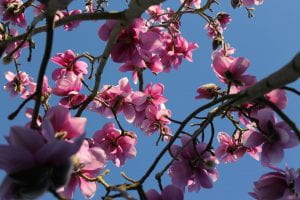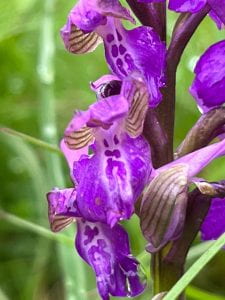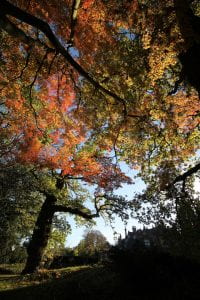 By Andy Winfield
By Andy Winfield
So, we’re at 2024, which seems a bit weird. 2020 seemed like it would never end, and now time is swishing by. Marking duration with dates and times is now baked into our way of existing; getting somewhere by a certain hour and organising an event for a particular date is how our lives work. St Augustine wrote in 400AD “No time is wholly present, all time is forced on by the future”. That was said a long time ago, and that idea has only accelerated. Humans today, myself included, are constantly looking ahead to the next thing, squeezing ever onwards. But what about now? What about the present? In the natural world, and the Botanic Garden, there are moments that aren’t defined by our perceptions of time; these moments give us opportunities to disembark the time train for a moment, and observe what’s happening right now, in the present.
Right now, as I write this, there are hellebores flowering along the driveway leading to the botanic garden. There are about ten or fifteen at the moment, but soon there will be hundreds of flowers. The thing about hellebores, is that the faces of the flowers look towards the ground, and all the flowers are all different from one another, and all are beautiful in their own way. To see these flowers, you need to stoop towards them, gently hold the stalk, then turn them over so they face you. It’s always a pleasure and a surprise seeing what patterns will be revealed when a flower is turned, a reward for a little effort, and short interlude that quiets the ticking of the clock.

In the middle of winter it feels like spring is a distant thing, but it always arrives; sometimes it’s held up by easterly beasts, or a northerly snowfall, but nothing can suppress it for long. The longer days and higher sun prompt buds to open and leaves and flowers to stretch into the season. Stopping at an acer, a beech hedge, or magnolia tree is a good interruption to the busy days of spring. It’s a season that speeds things up in the garden and in nature, but each bud takes its own time to open, and when it does, colour is unleashed on a seemingly monochrome winter world.

In the summer the Botanic Garden meadow sashays with the light warm winds; bees and butterflies make their way from bloom to bloom; there’s so much to see. I always take a little trip to watch the Bristol meadows in summer. Bristol is lucky to have a number of public places with areas left as a stable grassland habitat; this stability has led to the establishment of very healthy orchid populations. Like the hellebores in winter, the green winged orchids of Ashton Court are, for me, a valuable strategy for stopping time. There are thousands of them in shades from deep purple to white, all sharing the same familiar green stripes on their sepals. Last year I spent time slowly walking among them, feeling the breeze, seeing the beauty, and hearing the undulating songs of skylarks far above my head.
 In autumn the leaves fall; their colour can be breath-taking. The scrunchy sounds underfoot, the smell of fresh wet leaves, and the feel of a falling leaf brushing your head on its way to the floor is all unique to this season. Discarding the time for just one moment and staring up into a tree as the wind brings down the next batch of leaves can connect us with the season, minutes don’t exist, just that moment that makes us part of something else.
In autumn the leaves fall; their colour can be breath-taking. The scrunchy sounds underfoot, the smell of fresh wet leaves, and the feel of a falling leaf brushing your head on its way to the floor is all unique to this season. Discarding the time for just one moment and staring up into a tree as the wind brings down the next batch of leaves can connect us with the season, minutes don’t exist, just that moment that makes us part of something else.
Time is important to all of us, fitting things in has become a norm in our day to day; but taking a moment to connect with whatever ‘now’ nature is in, wherever we are, can be time very well spent.


Your reflection on the passing of time and the importance of embracing the present is beautifully expressed. The description of the hellebores and the changing seasons at the Botanic Garden vividly captures the timeless beauty of nature. It serves as a wonderful reminder to pause, appreciate the present moment, and find joy in the simple pleasures that nature offers. May your year at the University of Bristol Botanic Garden be filled with many more of these timeless moments.
Hello Natalia, and thank you. All the best from all of us here.
I have worked at the UOB since 1996 but never visited the Botanic Gardens – what an omission! My aim this year is to visit every month – I need that peace and quiet and beauty and colour in a busy, challenging life. Thanks for this resource in our City and University
Hi Nina, looking forward to seeing you in the Garden; do say hello when you visit and we can tell you what’s good in the Garden for that month.
A wonderful experience, gently walking through an excellent tour around Bristol University Botanic Gardens.
A delight to listen to the guide with so much knowledge! So inspirational!
I cannot wait for Spring,so many surprises for every one in the community and beyond.
Thank you for the opportunity to be part of nature beyond our dreams in Bristol.
At the University of Bristol Botanic Gardens.
This is one of my favourite blog posts I’ve ever read – you worded the way in which nature perceives time so wonderfully, and it really did make me pause to take in my surroundings. Really beautiful reflection, thank you for writing this Andy!
Thank you Leanna!